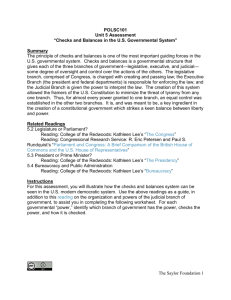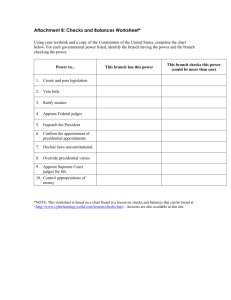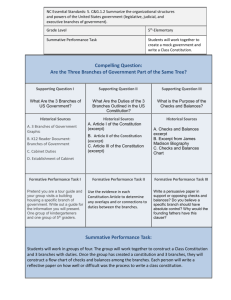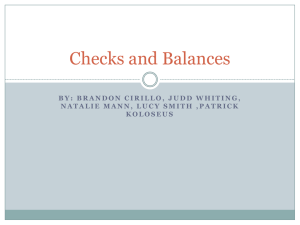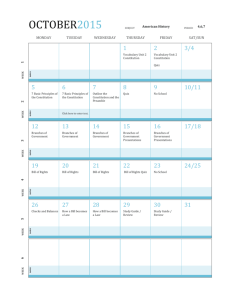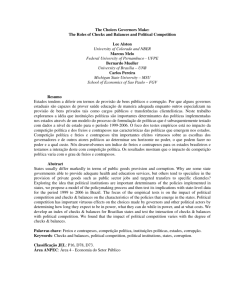Checks and Balances
advertisement
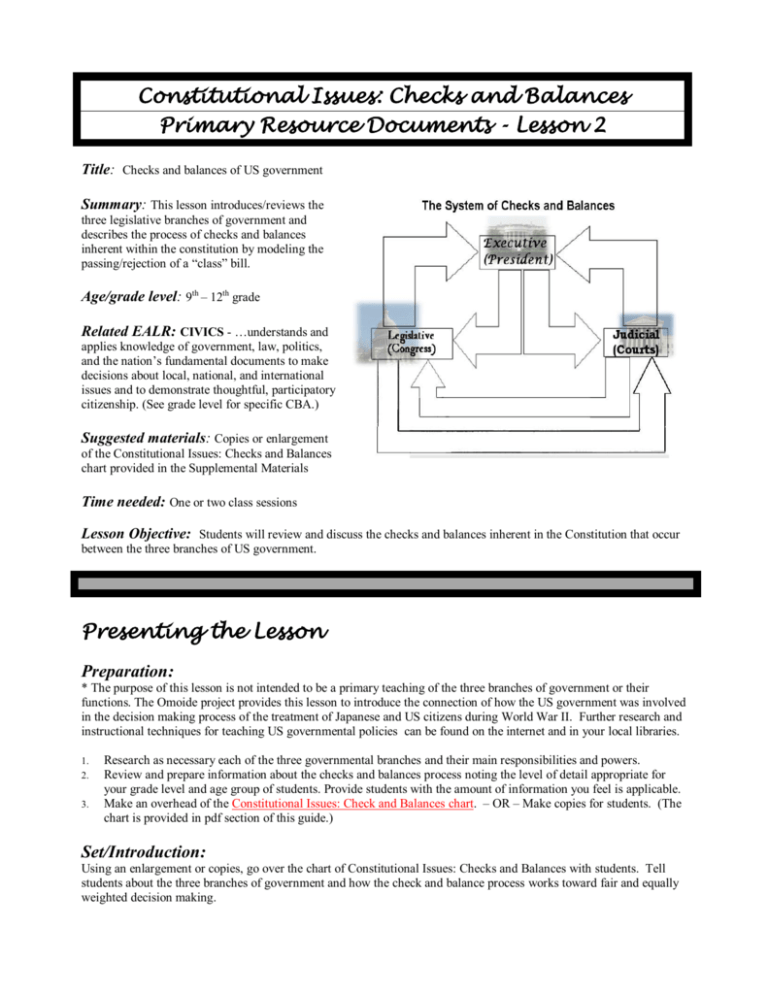
Constitutional Issues: Checks and Balances Primary Resource Documents - Lesson 2 Title: Checks and balances of US government Summary: This lesson introduces/reviews the three legislative branches of government and describes the process of checks and balances inherent within the constitution by modeling the passing/rejection of a “class” bill. Age/grade level: 9th – 12th grade Related EALR: CIVICS - …understands and applies knowledge of government, law, politics, and the nation’s fundamental documents to make decisions about local, national, and international issues and to demonstrate thoughtful, participatory citizenship. (See grade level for specific CBA.) Suggested materials: Copies or enlargement of the Constitutional Issues: Checks and Balances chart provided in the Supplemental Materials Time needed: One or two class sessions Lesson Objective: Students will review and discuss the checks and balances inherent in the Constitution that occur between the three branches of US government. Presenting the Lesson Preparation: * The purpose of this lesson is not intended to be a primary teaching of the three branches of government or their functions. The Omoide project provides this lesson to introduce the connection of how the US government was involved in the decision making process of the treatment of Japanese and US citizens during World War II. Further research and instructional techniques for teaching US governmental policies can be found on the internet and in your local libraries. 1. 2. 3. Research as necessary each of the three governmental branches and their main responsibilities and powers. Review and prepare information about the checks and balances process noting the level of detail appropriate for your grade level and age group of students. Provide students with the amount of information you feel is applicable. Make an overhead of the Constitutional Issues: Check and Balances chart. – OR – Make copies for students. (The chart is provided in pdf section of this guide.) Set/Introduction: Using an enlargement or copies, go over the chart of Constitutional Issues: Checks and Balances with students. Tell students about the three branches of government and how the check and balance process works toward fair and equally weighted decision making. Main activity: 1. 2. 3. 4. 5. 6. 7. Divide students into three “branches” of class government. Identify each group as the Executive, Legislative, and Judicial branch. Have each group appoint a speaker. For older or experienced students, you may decide to subdivide the Legislative branch into a Congress with a House and a Senate. Draw or model an overview of the process using arrows such as in the graphic depicted at the beginning of this lesson. Provide students with the following task which will go through the check and balance process of the class’ branches of government. (If time allows, you can have each branch come up with other bills or laws they create among themselves that more closely applies to your class.) Executive group presents the class with the executive order to the other two groups. “Be it proposed that class members who have lived outside this town/city will fund class projects in two ways: (1) Individual contributions of each member, a “project tax.” (2) Develop and sell a service to other classmates.” Allow time for each group to discuss the proposal. Encourage note taking for sharing later. Reconvene to see if all groups agree. If not, have the rescinding branch explain their concerns and redo the discussion process again until agreement is reached. If agreement is not reached by your designated time limit, table the proposal and define it as failed. Use the guided questions to assist discussions as needed. Secondary activity: See Executive Order 9066 provided in the pdf section of this guide. Using the main activity model, use Executive Order 9066 and discuss the constitutionality of the document. With students, speculate how the check and balance system may or may not have been used in executing the details of the order. Guided questions/Potential answers: How does a check and balance system help to insure all opinions can be voiced before bills or laws are accepted? (Each branch is informed and has a say in the passing of bills, which allows each branch an opportunity to exercise their expertise and agree or disagree.) What might occur if there was no check and balance system for governmental decisions? (Laws and decisions could be made from only one source without legal or fair consequences if the law is unjust.) How might the check and balance system fail? (If a bill or law is not fully disclosed or one party does not receive the complete information.) What does this process have to do with the Japanese and Japanese American internment process during WWII? (Answers will vary, but may include that the system isn’t fail proof because of the laws that passed.) Summary: Reiterate that the check and balance system was written to provide fair enactment of laws and bills for citizens of the US to live under. Pose a contemplative question of how injustice may still occur even with the system in play. Assessment options: Evaluate understanding of the checks and balances process based on the interaction of the students during the discussion times in the main activity. Take note of students’ level of involvement, including what is said, body language, and general attention. You can also have students write responses to the guided questions to rate understanding. Extensions/Follow up: Have students create their own graphic depictions of the following questions. What are the three branches of government? What are some of the primary responsibilities of each of the three branches of government? Additional Bibliography: See the provided list provided in the References/Bibliography section of this guide. Notes:
